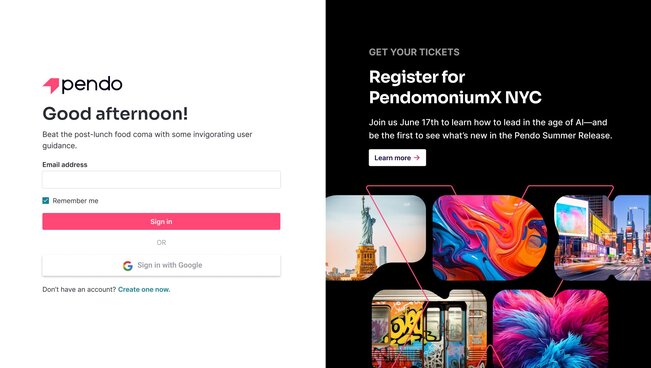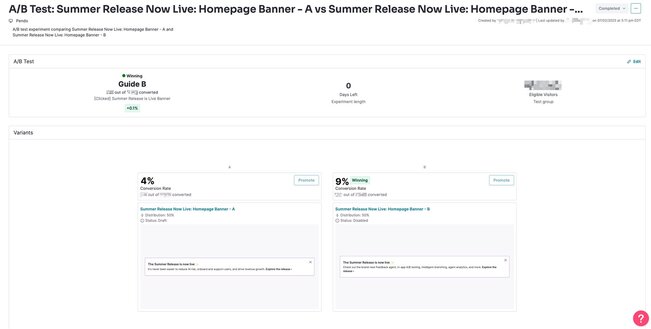In our home city of Raleigh, the cicadas are quieter, the mornings are cooler, and our team’s already pulling on light sweaters for early coffee runs. It feels like fall.
Before we dive into what’s next, we wanted to take a beat and reflect on our Summer Release. The entire company uses Pendo every day, and bringing you our Summer Release was no different. Not just because it’s our product, but because it helped us do two things at once: reach people where they are, and understand what resonated with users.
From Embedded Guides to usage data, Pendo gave us the tools to move fast and keep things connected.
Here’s what we tried, what worked, and how you can use Pendo to promote your next product release.
Building keynote anticipation (and registrations)
Before launch, we focused on warming up our audience so they’d be ready for the release. We tailored our outreach across key audiences, adjusting the messaging to reflect where each group was in their journey. We also used Pendo’s behavioral data to understand how different types of users ( enterprise vs. SMB) interacted with Pendo so we could greet them with relevant messages when they were ready to engage.
In-app, we embedded guides on login pages, app.pendo.io, and our marketing homepage to point users toward the Summer Release and upcoming events.

I’m not a developer, and with Pendo, I don’t have to be. The no-code designer made it easy to build and launch our in-app strategy in under five minutes, without asking engineering.
And the best part? This tactic ended up driving 36% (!) of our customer registrations for the keynote.
Launch day: a multi-channel moment
June 17 marked the kickoff of Pendo’s Summer Release. We started with a virtual keynote and PendomoniumX NYC, our in-person event. From there, we brought the momentum to Munich and Tokyo.
To promote everything the product team shipped, we built a release hub and installed Pendo. That simple step helped us track how specific accounts engaged with release content.
We even built account-level reports to share with the revenue team, showing exactly which customers were clicking, exploring, and signing up. It made follow-ups more personal, more relevant, and way more effective.
For our launch guides, we used the *brand new* Guide Experiments to A/B guide variations. We compared use case-focused messaging to product-focused versions. We learned that the more concise, value-forward version edged out its counterpart in clickthrough rate.

Keeping the momentum post-launch
Once the release was live, we didn’t let the energy fade. We shifted from “what’s coming” to “what’s new,” using follow-up emails and in-app messaging to guide users to deeper content, feature demos, and next steps.
We also experimented with sender personalization. The email with the highest click-through rate (CTR) came from Pendo CEO and co-founder, Todd Olson—not a brand alias.
This approach to our product releases was extremely successful: Pendo analytics told us that new functionality, like the Feedback Agent, Embedded Guides, and Web Analytics, saw a significant increase in both visitors and usage post-release.
What we learned (and what we’ll try next)
Balance scale with simplicity
We used Pendo to segment users by customer type, product usage, and behavior. But we didn’t overcomplicate it. In some cases, a universal in-app guide outperformed a multi-email nurture.
Blend channels for more impact
One in-app guide drove 36% of keynote signups, and it took two emails to get to 50%. But the real magic happened when both channels worked together.
Move fast, learn faster
Pendo’s A/B testing and behavioral data gave us a clear view into what messaging resonated, and what users ignored. For our future releases, we’ll start with what worked best from the Summer Release, while continuing to test and optimize along the way.
What’s next: playbooks, PSLs, and planning for autumn
We’re already thinking ahead to our Autumn Release, exploring new ways to deepen in-app engagement (like testing new guide formats and embedding microsite content directly into the product).
Pendo helped our marketing and product teams move quickly, stay aligned, and learn in real-time, and how valuable it is to use the same tools we build for our customers. Pendo isn’t just for product and IT teams, it’s for anyone that wants to deepen their customer relationships and knowledge.
We’re curious: how are you using Pendo to support your own launches?
![[object Object]](https://cdn.builder.io/api/v1/image/assets%2F6a96e08774184353b3aa88032e406411%2F16b6f2565d1d4a5585db322386f9be7f?format=webp)
![[object Object]](https://cdn.builder.io/api/v1/image/assets%2F6a96e08774184353b3aa88032e406411%2F728d67faa5f64299b8f8f0b138881fb5?format=webp)
![[object Object]](https://cdn.builder.io/api/v1/image/assets%2F6a96e08774184353b3aa88032e406411%2Fc08c4160a2724c4fa3d365eb43791b09?format=webp)
